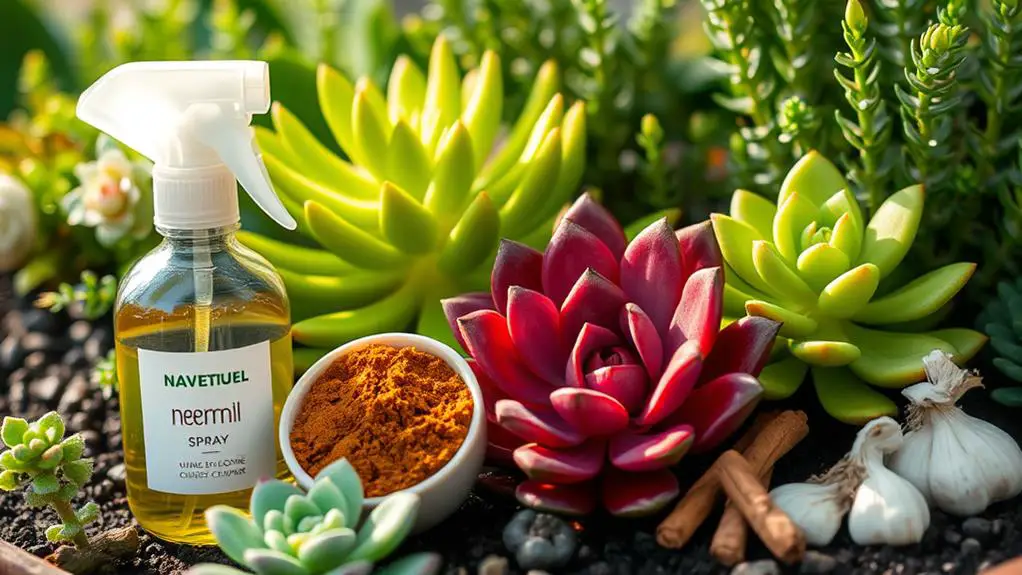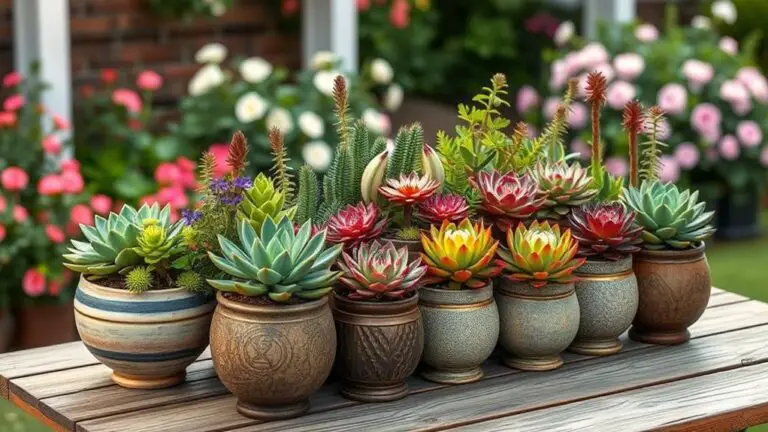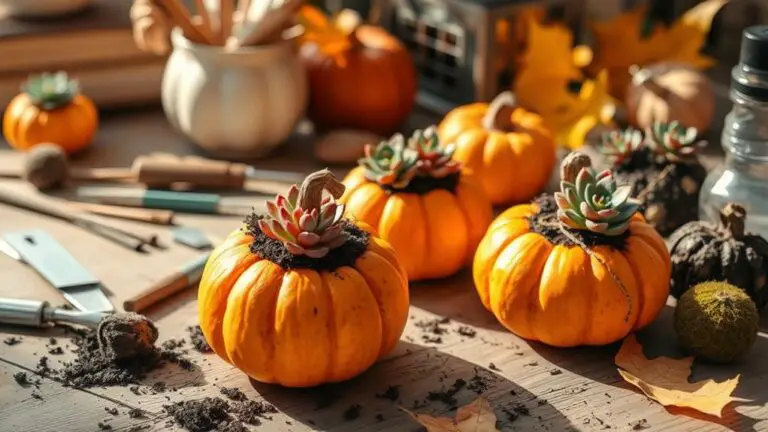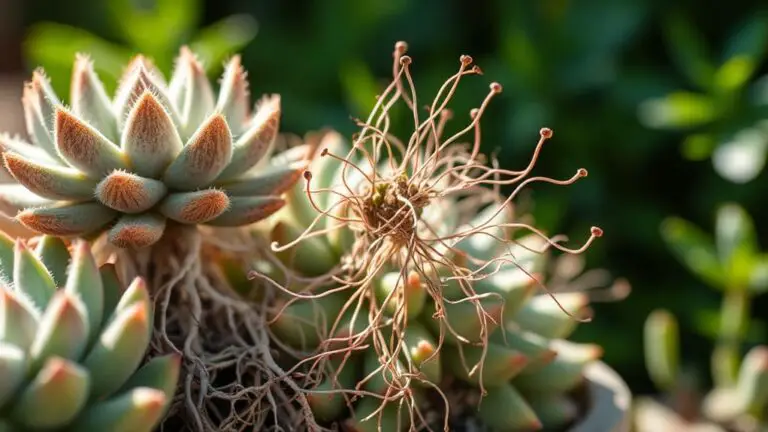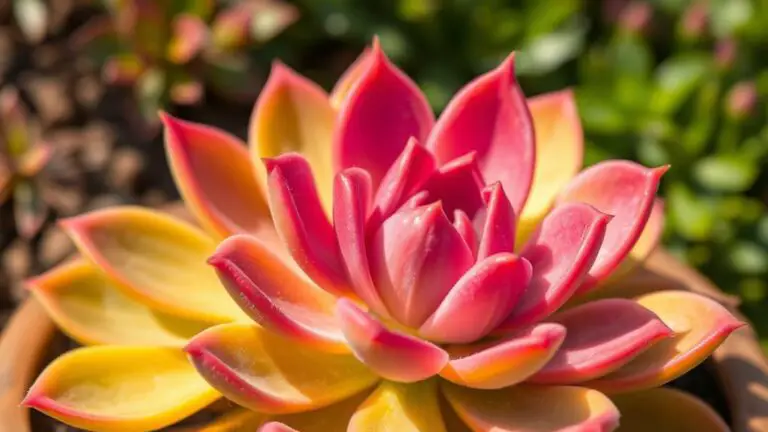Effective Natural Treatments for Their Succulent Fungus
You've noticed a troubling white powder on your succulent leaves or perhaps some black sooty spots, and you're wondering how to address these fungal issues naturally. Well, you're not alone and fortunately, there are effective methods to tackle these problems without resorting to harsh chemicals. From simple baking soda solutions to the benefits of neem oil, each treatment has its unique advantages. But before you jump into action, it's essential to understand why these fungi appear in the first place and how you can prevent them from recurring. So, what's the best way to keep your succulents fungus-free?
Understanding Succulent Fungus
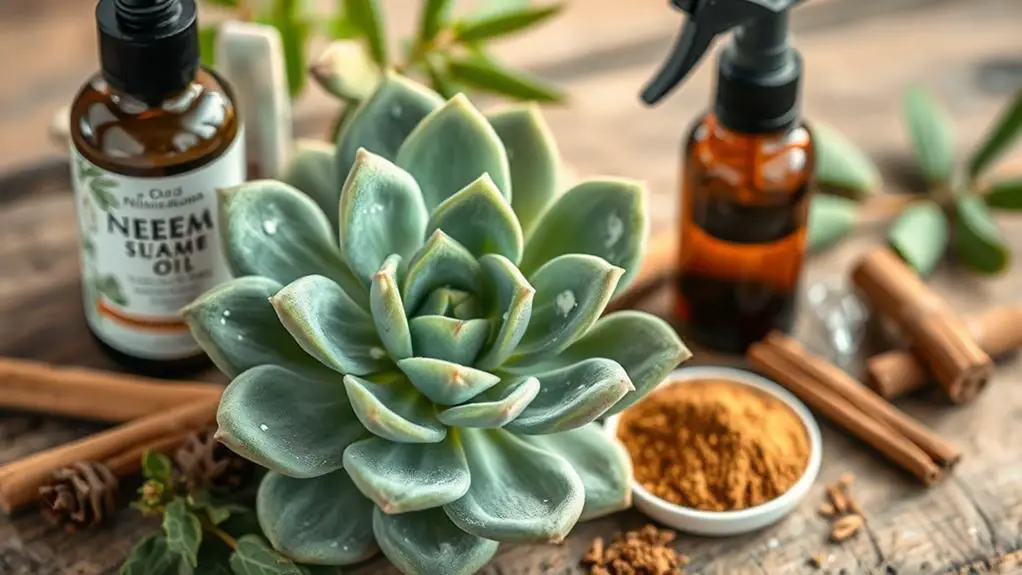
Understanding succulent fungus is vital for maintaining the health and longevity of your plants. Fungal infections can make your succulent plants look sick with symptoms like discoloration, wilting, and mold. These issues often happen because of overwatering and poor drainage. When water sits in the soil too long, it creates a perfect home for fungal spores to grow.
You might notice specific fungal issues like powdery mildew, which looks like a white powder, or grey mold, which appears as gray fuzzy spots. These fungi thrive in certain environmental conditions, especially high humidity and poor airflow. Consequently, it's important to keep an eye on your plants and their surroundings.
Regular monitoring of your succulent plants helps you spot fungal symptoms early. Early identification is key to preventing severe infections. Adjusting environmental conditions, like improving airflow and reducing humidity, can help. For example, make sure your succulents aren't overcrowded and have good ventilation.
When you do spot fungal infections, there are natural treatments available. These treatments can help manage and even eliminate the fungus, keeping your plants healthy.
Common Fungal Infections
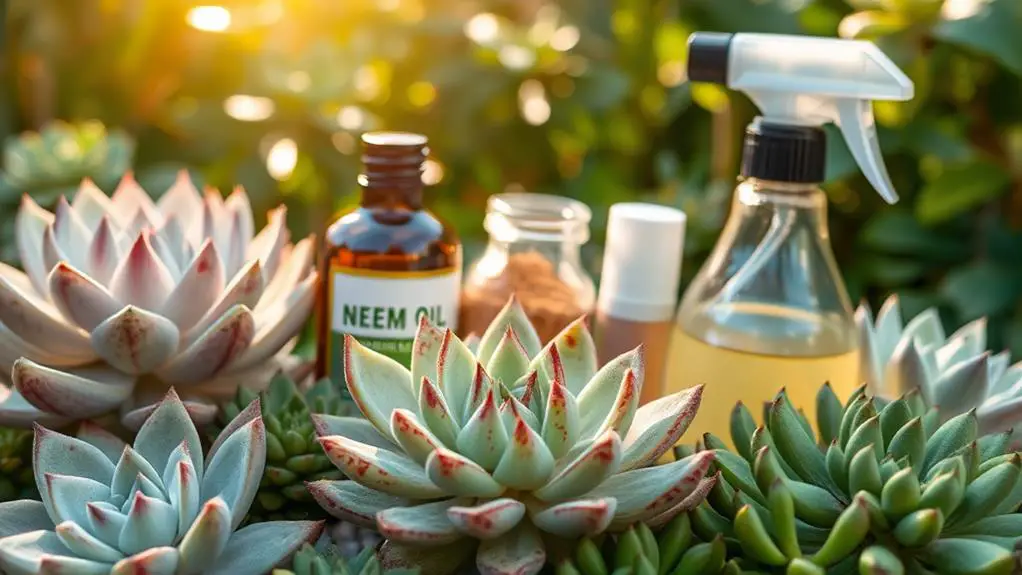
Encountering common fungal infections in your succulents can be frustrating, but recognizing their symptoms early can make treatment more effective. Common problems include powdery mildew, sooty mold, grey mold, and leaf spots. Let's break these down:
| Fungal Infection | Appearance | Treatment |
|---|---|---|
| Powdery Mildew | White, powdery coating on leaves | Baking soda solution or all-purpose fungicide |
| Sooty Mold | Black or dark brown growth | Address pests first, then clean leaves |
| Grey Mold | Fuzzy gray-brown spots | Remove affected areas, improve airflow |
| Leaf Spots | Small lesions that enlarge | Baking soda solution or all-purpose fungicide |
| Fusarium Wilt | Yellowing, wilting | Prevention only, no effective treatment |
Powdery mildew looks like a white, powdery coating on leaves. If your succulent's infected, try a baking soda solution or an all-purpose fungicide. Sooty mold is black or dark brown and often signals sap-sucking pests. You'll need to treat the pests and then clean the leaves.
Grey mold, appearing as fuzzy gray-brown spots, thrives in moist conditions. Remove affected areas and improve airflow around your plants. Leaf spots start small but can grow. Treat these spots with a baking soda solution or fungicide. Unfortunately, Fusarium wilt has no known cure, so focus on prevention.
Powdery Mildew Treatments
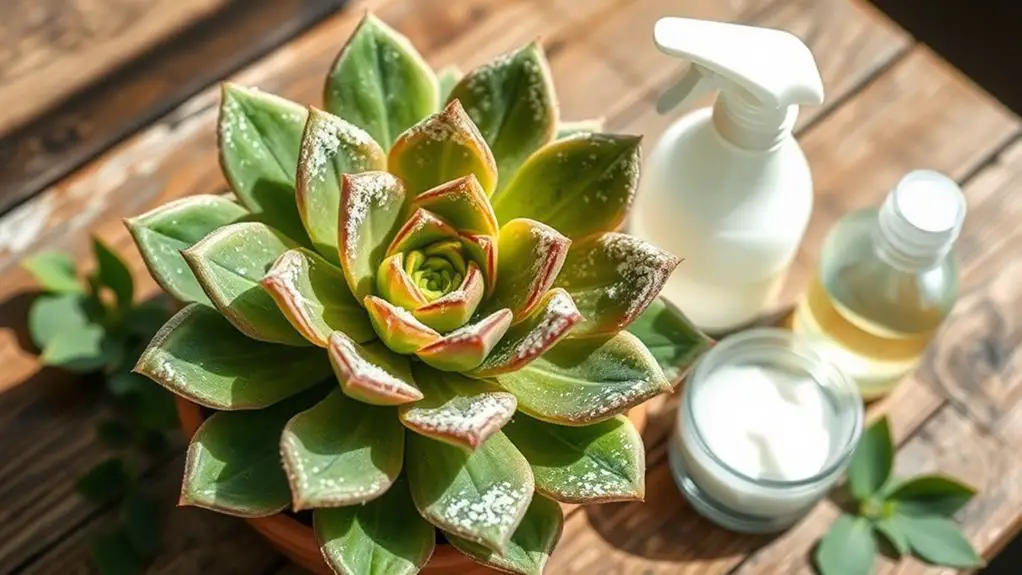
Spotting powdery mildew on your succulents can be disheartening, but there are effective natural treatments to tackle this issue.
Powdery mildew is a fungal infection that shows up as a white, powdery coating on leaves and stems, especially in humid conditions. To combat this, you can mix 1 tablespoon of baking soda and 1 teaspoon of non-detergent soap in a gallon of water. Spray this solution on the affected leaves to inhibit fungal growth.
Neem oil is another great option. It acts as a natural fungicide and should be mixed with water according to the product's instructions.
Apply it to your succulents in the evening to avoid leaf burn from sunlight. This allows the solution to work overnight, targeting the powdery mildew effectively.
Sooty Mold Remedies
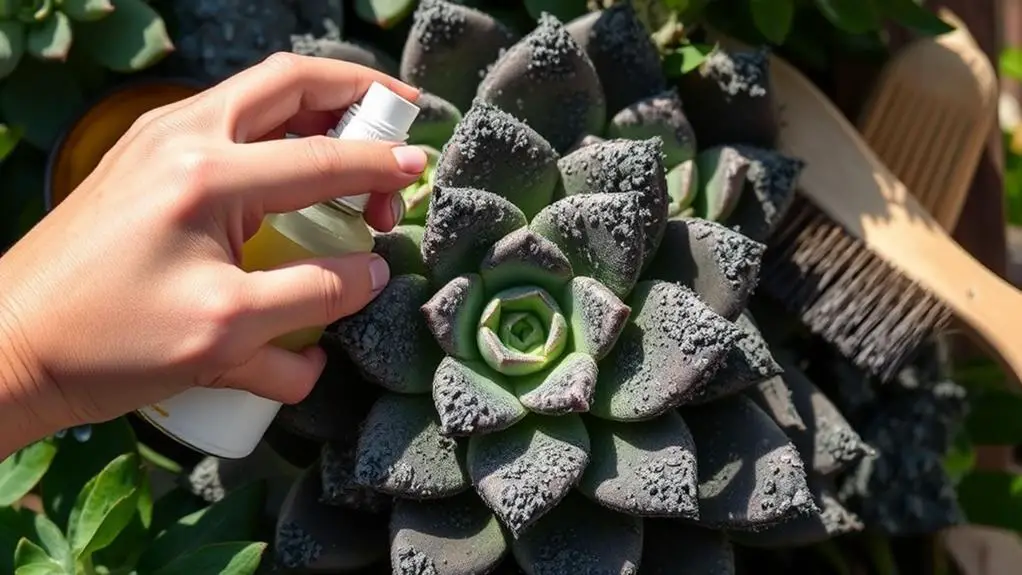
Sooty mold shows up as a black, powdery coating on your succulent leaves, often signaling the presence of pests like aphids or mealybugs.
To tackle it naturally, you can apply neem oil or horticultural oil directly to the affected areas, which helps get rid of both the mold and the pests.
Additionally, a simple mixture of water and mild dish soap can help wipe away the mold, breaking down the sticky substances that allow it to grow.
Identifying Sooty Mold
When you notice a black or dark brown growth on your succulent leaves, it's likely you're dealing with sooty mold, a common indication of sap-sucking pests like aphids or mealybugs.
This mold doesn't directly harm your succulents, but it can block sunlight and hinder photosynthesis, which can impact your plant's health over time.
The key to managing sooty mold lies in addressing the sap-sucking pests causing it. Applying neem oil or organic horticultural oil to your succulents effectively eliminates these pests.
Regularly washing the leaves with a diluted soap solution can help remove the sooty mold and prevent it from returning. This simple step can make a significant difference in maintaining your plant's overall health.
Good airflow around your succulents is also essential. It helps reduce the likelihood of pest infestations and, consequently, sooty mold.
Make it a habit to inspect your plants regularly for any signs of pests. Early detection is critical in keeping your succulents healthy and mold-free.
Natural Treatment Methods
Combatting sooty mold on your succulents begins with natural treatment methods that are both effective and gentle on your plants. One of the best natural remedies is Neem oil. Not only does it target the sooty mold, but it also eliminates the pesky sap-sucking insects that cause the mold in the first place. Simply spray Neem oil on the affected areas to see results.
Another helpful solution is horticultural oil. This oil can be sprayed directly onto your succulent's leaves, suffocating the mold and deterring pests without causing harm.
Regularly cleaning leaves with a damp cloth also works wonders. It physically removes the sooty mold buildup and helps your plant stay healthy.
Good pest management is essential. By addressing insect infestations early, you can prevent sooty mold from taking hold.
Ensuring proper air circulation around your succulents is key as well. Good airflow helps reduce moisture, which is a breeding ground for mold.
Grey Mold Solutions
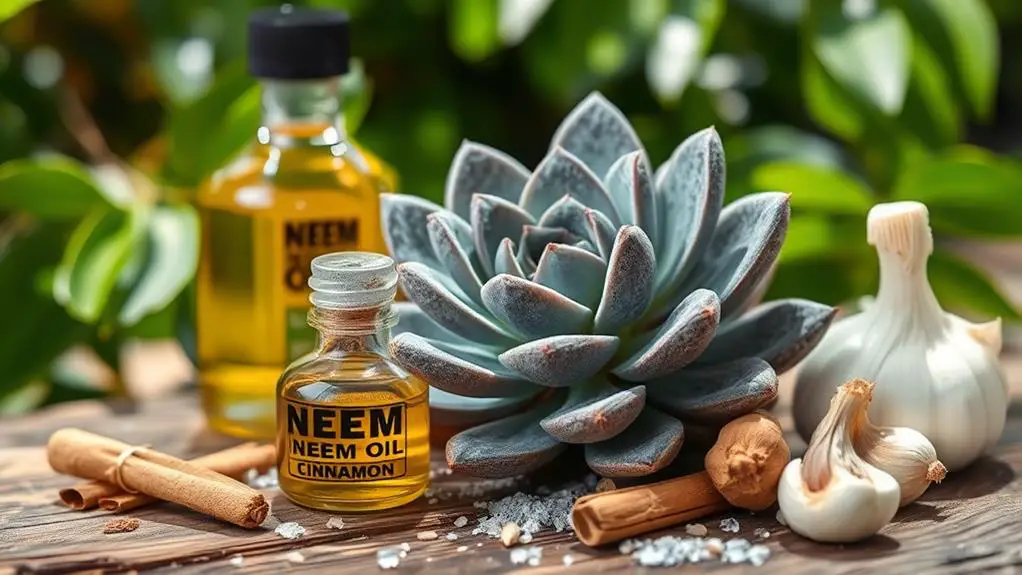
Grey mold, scientifically known as Botrytis cinerea, can quickly become a gardener's nemesis if not addressed promptly. This fungal growth thrives in moist environments and is identifiable by its gray-brown fuzzy spots on leaves and stems.
To combat grey mold, you can use a solution of dishwashing soap mixed with water. Simply apply it directly to the affected areas; this disrupts the fungal growth. It's a simple but effective natural treatment.
Besides using soap, you need to manage the environment around your plants. Reducing humidity and ensuring proper air circulation are vital. Grey mold loves damp conditions, so keeping the air moving around your succulents can help keep it at bay.
Here are three essential steps to manage grey mold:
- Reduce Humidity: Use a dehumidifier or improve ventilation.
- Ensure Air Circulation: Space plants apart and use fans if needed.
- Inspect Regularly: Look for early signs like soft, water-soaked spots to act quickly.
If you find grey mold, cut away the affected parts of the plant. Make sure you don't contaminate the healthy tissue.
With these steps, you can protect your succulents from grey mold and keep them thriving.
Leaf Spot Management
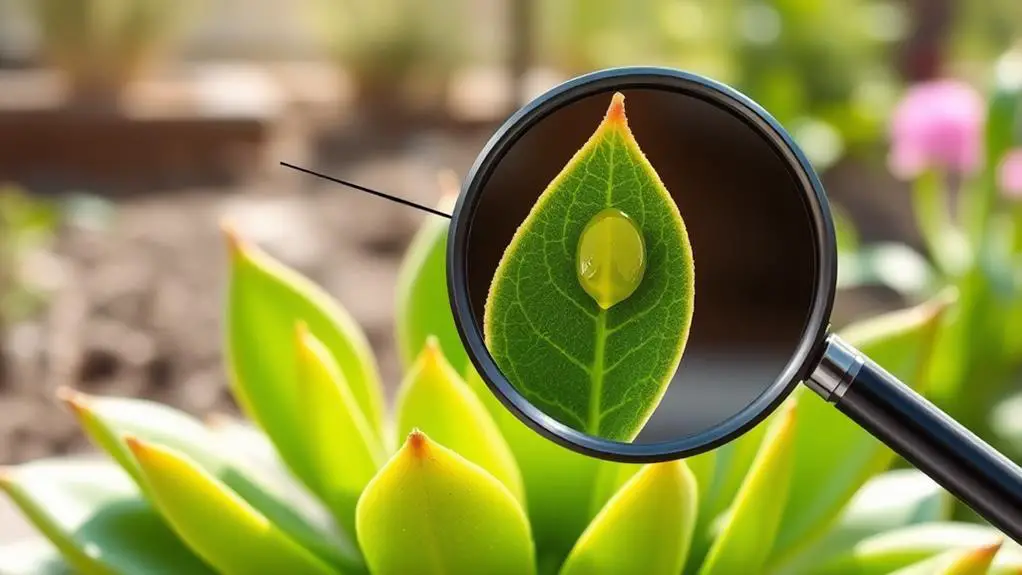
Leaf spots on succulents, often the result of fungal infections, can start as tiny dots and expand into unsightly blotches if not promptly addressed.
To manage these leaf spots, you can use an all-purpose fungicide or a homemade baking soda solution. Simply mix half a teaspoon of baking soda per gallon of water for effective treatment. This helps to combat fungal infections naturally.
Regularly inspect your succulents for early signs of leaf spots. Catching the problem early can prevent the spread of the infection to other leaves. If you notice affected leaves, remove them promptly using clean, sterilized tools. This minimizes the risk of spreading the infection to healthy parts of the plant.
Maintaining good air circulation around your succulents is essential. Proper airflow helps prevent the conditions that lead to leaf spot development.
Additionally, maintaining lower humidity levels around your plants can discourage fungal growth.
Fusarium Wilt Actions
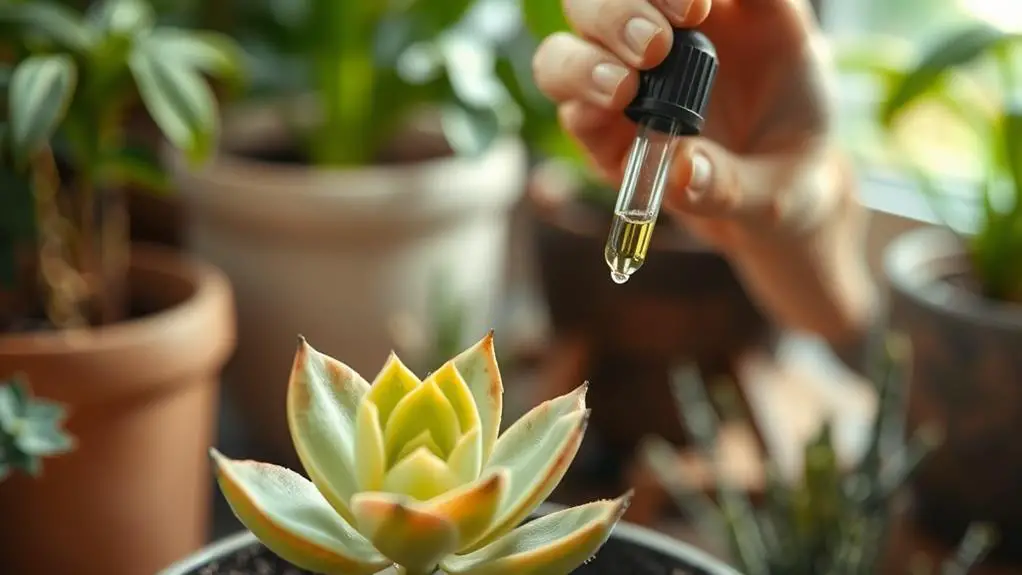
When dealing with Fusarium wilt, a soil-borne fungal disease, it's crucial to act swiftly to protect your succulents. Fusarium wilt causes yellowing and wilting of leaves, leading to the decline of your plant's health. Since there's no effective treatment, the only solution is to remove and dispose of affected plants immediately. This prevents the fungus from spreading to healthy plants.
To manage Fusarium wilt, follow these steps:
- Remove and dispose of affected plants: As soon as you notice early signs like yellowing or wilting, take action. Carefully remove the infected plant and make certain you dispose of it far from your garden.
- Use clean, sterile soil: When replanting, guarantee you use fresh, sterile soil and clean pots. This helps eliminate any lingering spores that could infect new plants.
- Practice proper watering: Overwatering is a significant risk factor. Confirm your succulents have good drainage and only water them when the soil is dry. This helps prevent the conditions that allow the soil-borne fungus to thrive.
Preventive Measures
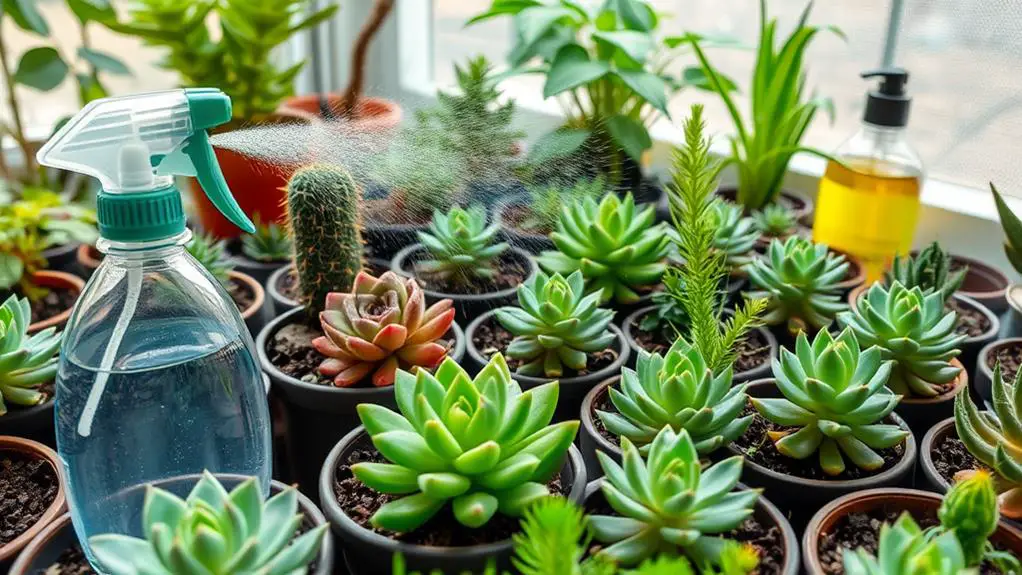
To keep your succulents healthy and fungus-free, start by planting them in well-draining soil mixed with perlite or sand.
Water only when the soil is completely dry to avoid overwatering, which can lead to fungal infections.
Also, choose terracotta pots to help wick away moisture and maintain proper airflow around your plants.
Proper Watering Techniques
How can you ascertain your succulents stay healthy and free from fungal infections? Practicing proper watering techniques is essential. Water your succulents only when the soil is completely dry to avoid moisture accumulation, which can lead to fungal infections and root rot.
Here's a simple guide to help you manage their watering needs effectively:
- Thorough Watering: Soak the soil until water drains from the bottom of the pot through the drainage holes. This guarantees the soil gets enough moisture without staying soggy.
- Drying Out Period: Allow the soil to dry out completely before the next watering. Typically, during the growing season, you should water every 1-2 weeks. In the dormancy period (often winter), reduce watering to once every 3-4 weeks.
- Monitor Humidity: High humidity can increase the risk of fungal infections. If you notice that the air around your plants is consistently humid, reduce the watering frequency to keep the soil dry.
Soil and Pot Selection
Making sure your succulents stay healthy and free from fungal infections goes beyond just proper watering techniques. Choosing the right soil and pot can make a big difference.
Start with well-draining soil mixes designed for succulents, which often include ingredients like perlite or sand. These components help reduce moisture retention and prevent fungal growth, keeping your plants dry and healthy.
Terracotta pots are an excellent choice because they're porous and help with evaporation. This type of pot keeps the soil dry, reducing the chance of fungal infections.
Also, verify that your pots have drainage holes. These holes allow excess water to escape, preventing standing water that can cause root rot and create a favorable environment for fungi.
Before replanting, always sterilize pots to eliminate any lingering contaminants. This step is vital to decrease the risk of fungal infections.
Monitoring humidity levels in your environment is also important. High humidity can lead to increased fungal activity.
Place your succulents in well-ventilated areas to promote airflow around the succulent leaves. This helps keep humidity levels in check and guarantees your plants stay healthy.
Post-Treatment Care
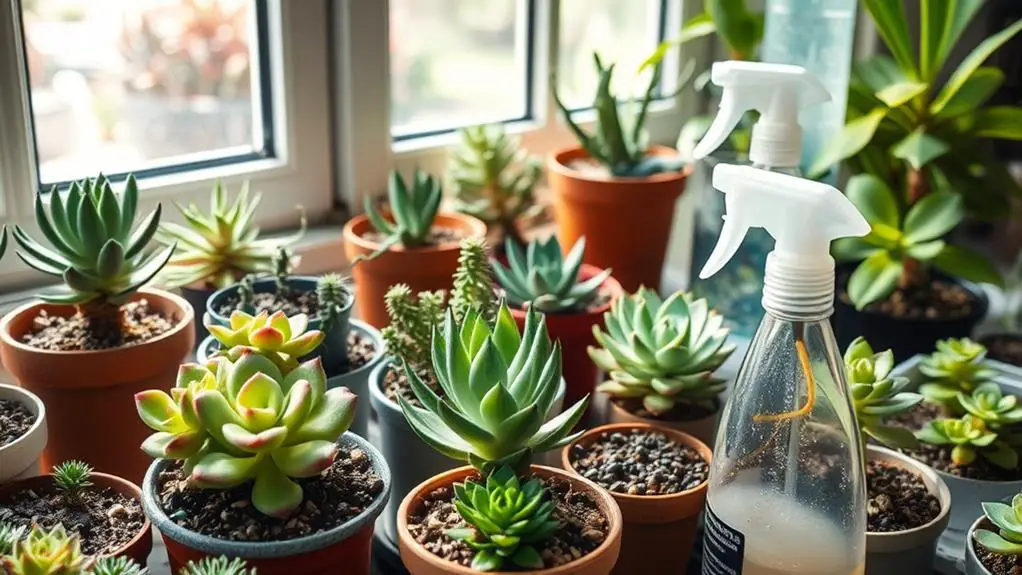
After treating your succulents for fungus, it's important to implement a few key steps to guarantee they recover fully and remain healthy.
First, focus on removing any affected leaves and debris to reduce recurrence and promote airflow around the plant. This helps in preventing fungal return.
Next, closely monitor plants for any signs of fungal return. Look for discoloration, wilting, or mold growth regularly. This vigilance will help catch any issues early.
Providing adequate sunlight after treatment is essential. Bright light strengthens your succulents and reduces humidity levels that favor fungi.
Make sure to gradually reintroduce water to succulents, allowing the soil to dry completely between watering sessions. This practice is crucial to prevent further fungal growth.
Here's a quick guide to post-treatment care:
- Remove Debris: Clear out affected leaves and any surrounding debris to reduce recurrence and improve airflow around the plant.
- Monitor Regularly: Check your plants frequently for signs of fungal return, focusing on discoloration, wilting, or mold growth.
- Sunlight and Watering: Ensure succulents get adequate sunlight and dry out completely between waterings.
Frequently Asked Questions
How to Cure Fungus on Succulents?
To cure fungus on your succulents, spray neem oil mixed with water, or use a baking soda solution. For powdery mildew, try baking soda with non-detergent soap. Regularly inspect your plants and guarantee proper airflow and sunlight.
What Is a Homemade Fungal Treatment for Plants?
You can mix one tablespoon of baking soda, one teaspoon of non-detergent soap, and one gallon of water. Spray this on your plants to combat fungal infections like powdery mildew. It's an effective, natural solution.
How to Treat Soil Fungus Naturally?
Mix 1 tablespoon of baking soda with 1 gallon of water and apply it to the soil. You can also use cinnamon powder, diluted vinegar, or neem oil. Regularly aerate the soil for best results.
Does Vinegar Get Rid of Plant Fungus?
Yes, vinegar can help get rid of plant fungus. Dilute white vinegar with water (one part vinegar to three parts water) and apply cautiously. Use it in the evening or on cloudy days to avoid leaf burn.
Conclusion
You've got all the tools you need to tackle succulent fungus naturally. By using baking soda, neem oil, and ensuring good air circulation, your plants can stay healthy. Don't forget to inspect regularly and remove any affected leaves quickly. Maintain well-draining soil and water properly to keep fungal infections at bay. With these tips, your succulents will thrive, and you'll feel confident in your gardening skills. Happy growing!

